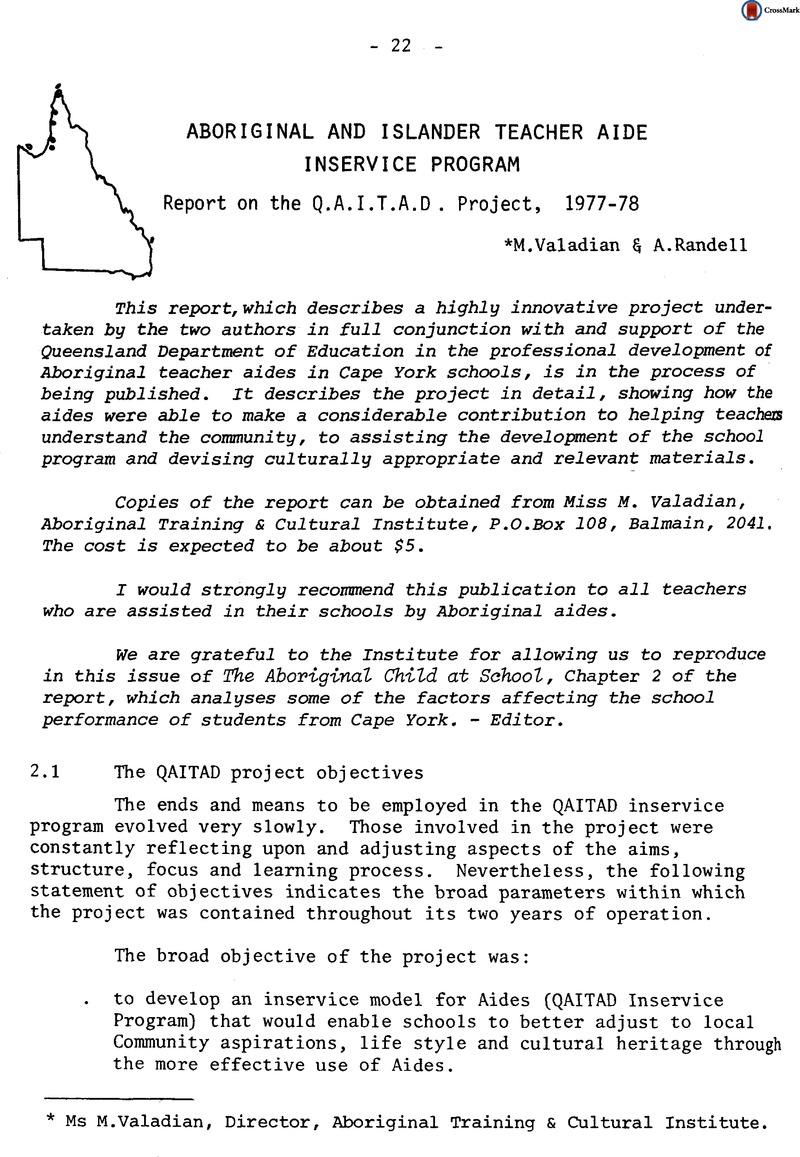Article contents
Aboriginal and Islander Teacher Aide Inservice Program: Report on the Q.A.I.T.A.D. Project, 1977-78
Published online by Cambridge University Press: 22 July 2015
Abstract

- Type
- Other
- Information
- Copyright
- Copyright © Cambridge University Press 1980
References
page 24 note 1 The quote from “a letter from an American Indian mother” exemplifies the nature of the concerns basic to this viewpoint:
“Dear Teacher:
...What are the stereotypes and untested assumptions that you bring with you into the classroom? How many negative attitudes towards Indians will you put before my child? What values, class prejudices and moral principles do you take for granted as universal? Please remember that ‘different from’ is not the same as ‘worse than’ or ‘better than’, and the yardstick you use to measure your own life satisfactorily may not be appropriate for their lives. The term ‘culturally deprived’ was invented by well-meaning middle-class whites to describe something they could not understand...”
Source: Appendix – Report of the First National Aboriginal Teacher Aide Three Day Workshop and One Day Seminar, June 19-22, 1978,ATCI, Copies from P.O.Box 108, Balmain, NSW, 2041.
page 26 note 1 See for instance Beare, Hedley. The city as a school: a plan for education in new towns and cities. Towards the Learning Society. Australian College of Education, 1975.
page 27 note 1 In addition, the Queensland Van Leer Language Development Program was specifically based on a knowledge of the language that children brought with them. However, many teachers in the project schools were not familiar with the program; some questioned its appropriateness to Cape York schools; and on the whole it had not been widely or successfully used in these schools.
page 28 note 1 Hall, L.: Teaching skills in an Aboriginal school. New Education, Vol.1, No. 1, Oct. 1978, p.99.Google Scholar
page 28 note 2 In 1980, thirty four out of forty two new teachers for Cape York schools were graduates in their first year out of College. Queensland Department of Education has since introduced a policy to ensure this cannot happen in the future.
page 30 note 1 By 1978 this rate had fallen to figures closer to 50%.
page 30 note 2 In a survey of Aboriginal & Islander Classroom Assistants & Urban Aides in Queensland Primary Schools, L.J.Dwyer (Queensland Dept. of Education, Oct.1976), noted that there was a considerable core of Aides who had been employed for two years or more (see Table 4.8) “An examination of this sample reveals that, within this ‘core’ group there is a very high rate of job retention”, (p.23). Table 4.9 al so indicated 71% of the sample were twenty six years of age or more.
page 31 note 1 Average stay of non-Aboriginal and non-Islander staff is two years or less. A few remain for three years or seek another Aboriginal or Islander Community appointment. However, such teachers are relatively few in number.
page 31 note 2 There are three high school graduates enrolled in the Teacher Diploma Course in 1979: two at Townsville CAE and one at Torrens CAE.
- 3
- Cited by


